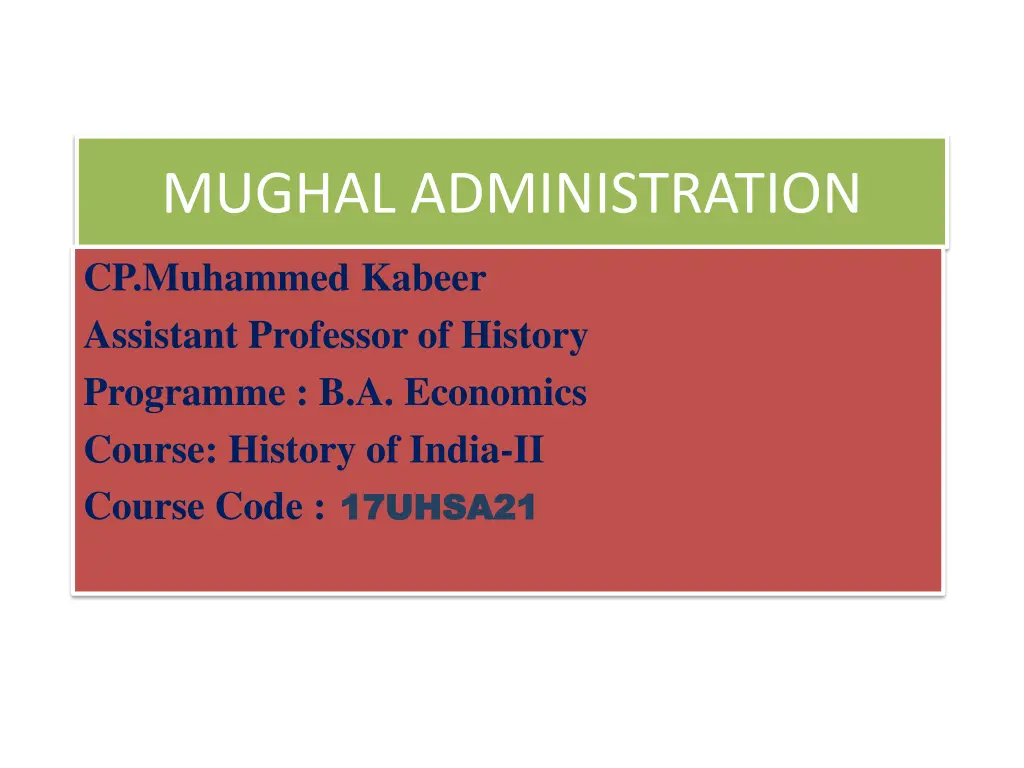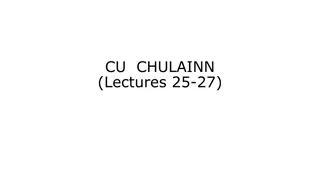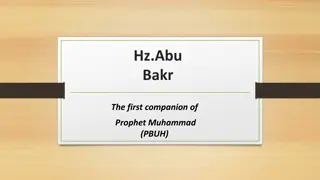
Mughal Administrative Structure and Centralization Overview
Explore the evolution of Mughal administration under rulers like Shershah and Akbar, focusing on key offices like the Diwan-i-Kul and Mir Bakshi. Understand the centralization of power and the Emperor's role in the bureaucratic system.
Download Presentation

Please find below an Image/Link to download the presentation.
The content on the website is provided AS IS for your information and personal use only. It may not be sold, licensed, or shared on other websites without obtaining consent from the author. If you encounter any issues during the download, it is possible that the publisher has removed the file from their server.
You are allowed to download the files provided on this website for personal or commercial use, subject to the condition that they are used lawfully. All files are the property of their respective owners.
The content on the website is provided AS IS for your information and personal use only. It may not be sold, licensed, or shared on other websites without obtaining consent from the author.
E N D
Presentation Transcript
MUGHAL ADMINISTRATION CP.Muhammed Kabeer Assistant Professor of History Programme : B.A. Economics Course: History of India-II Course Code : 17UHSA21 17UHSA21
Bureaucracy retained The administrative system of the Sultanate and Shershah. Under Shershah The administrative units of Pargana (a group of villages), sarkar (a group of parganas) and groups of sarkars (some what like subas or province) were placed under specific offices. The Mughals formalized a new territorial unit called suba. Institutions of Jagir and Mansab system were also introduced by the Mughals. Thus change and continuity both marked the Mughal administrative structure which brought about a high degree of centralisation in the system. Mughals many features of the
CENTRAL ADMINISTRATION (i) The Emperor The Emperor was the supreme head of the administration and controlled all military and judicial powers. All officers in Mughal administration owed their power and position to the Emperor. The Emperor had authority to appoint, promote, and remove officials at his pleasure. There was no pressure institutional or otherwise on the Emperor. For smooth functioning of the empire a few departments were created.
(ii) Wakil and Wazir The institution of Wizarat (or Wikalat since both were used interchangeably) was present in some form during the Delhi Sultanate also. The position of Wazir had lost its preeminent position during the period of Afghan rulers in the Delhi Sultanate. The position of the wazir was revived under the Mughals. Babur s and Humayun s wazir enjoyed great powers. The period during which Bairam Khan (1556 60) was regent of Akbar, saw the rise of wakil-wazir with unlimited powers. Akbar in his determination to curb the powers of wazir later on took away the financial powers from him. This was a big jolt to wazir s power.
(iii) Diwan-i-Kul Diwan-i Kul was the chief diwan. He was responsible for revenue and finances. Akbar had strengthened the office of diwan by entrusting the revenue powers to the diwan. The diwan used to inspect all transaction and payments in all departments and supervised the provincial diwans. The entire revenue collection and expenditure of the empire was under his charge. The diwans were to report about state finance to the Emperor on daily basis.
(iv) Mir Bakshi Mir Bakshi looked after all matters pertaining to the military administration. The orders of appointment of mansabdars and their salary papers were endorsed and passed by him. He kept a strict maintenance of the sanctioned size of armed contingents( ) equipage( ) by the mansabdars. The new entrants seeking service were presented to the Emperor by the Mir Bakshi. watch over proper and war
(v) Sadr-us Sudur The head of the ecclesiastical department. His chief duty was to protect the laws of the Shariat. The office of the Sadr used to distribute allowances and stipends to the eligible persons and religious institutions. It made this office very lucrative during the first twenty-five years of Akbar s reign. The promulgation of Mahzar in 1580 restricted his authority.
According to Mahzar Akbars view was to prevail in case of conflicting views among religious scholars. This officer also regulated the matters of revenue free grants given for religious and charitable purposes. Later several restrictions were placed on the authority of the Sadr for award of revenue free grants also. Muhtasibs (censors of public morals) were appointed to ensure the general observance of the rules of morality. He also used to examine weights and measures and enforce fair prices etc.
(vi) Mir Saman The Mir Saman was the officer in-charge of the royal Karkhanas. He was responsible for all kinds of purchases and their storage for the royal household. He was also to supervise the manufacturing of different articles for the use of royal household.
Provincial Administration The Mughal Empire was divided into twelve provinces or subas by Akbar. These were Allhabad, Agra, Awadh, Ajmer, Ahmedabad, Bihar, Bengal, Delhi, Kabul, Lahore, Malwa and Multan. Later on Ahmednagar, Bearar and Khandesh were added. With the expansion of Mughal empire the number of provinces increased to twenty. Each Suba was placed under a Subedar or provincial governor who was directly appointed by the Emperor.
Subedar The Subedar was head of the province and responsible for maintenance of general law and order. He was to encourage agriculture, trade and commerce and take steps to enhance the revenue of the state. He was also to suppress rebellions and provide army for expeditions.
Diwan The head of the revenue department in the suba was the Diwan. He was appointed by the Emperor and was an independent officer. He was to supervise the revenue collection in the suba and maintain an account of all expenditures. He was also expected to increase the area under cultivation. In many cases advance loans (taqavi) were given to peasants through his office.
Bakshi The Bakshi in the province performed the same functions as were performed by Mir Bakshi at the centre. He was appointed by the imperial court at the recommendations of the Mir Bakshi. He was responsible inspecting the horses and soldiers maintained by the mansabdars in the suba. He issued the pay mansabdars and the soldiers. for checking and bills of both the
Sadr The representative of the central Sadr (Sadr- us sudur) at the provincial level was called Sadr. He was responsible for the welfare of those who were engaged in religious activities and learning. He also looked after the judicial department and in that capacity supervised the works of the Qazis.
Other Provincial Level officers There were some other officers also who were appointed at the provincial level. Darogai-i-Dak was maintaining the communication channel. He used to pass on letters to the court through the postal runners (Merwars). Waqainavis and waqainigars were appointed to provide reports directly to the Emperor. responsible for





















